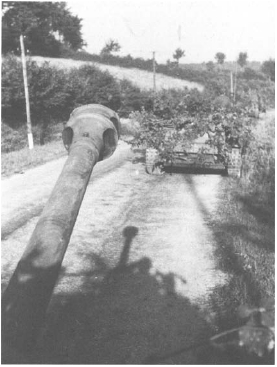
SCHWERPUNKT
IS
SOUTH!
encouraging. As always, the ground insouthern Holland mitigated against vonMaltzahn's need to concentrate the mass ofhis armour into a solid punch, sufficient tooverwhelm his lightly armed oppositionwith one massive armoured blow. Thiswas not to happen. Reluctant to commithis brigade to going recklessly into theunknown, von Maltzahn decided upon areconnaissance in force. His chosenapproach from the south-east towards Sonwas flat, but sandy and boggy; Eindhovento his left was probably now occupied, andthe axis of advance was further channelledby the line of the Wilhelmina canal itself,an obstacle forward and to the right. Asmall river tributory running due southfrom the canal, parallel to Eindhoven, res-tricted armoured movement even further.Weighing up his options, gazing throughbinoculars, von Maltzahn realised that hisinitial objective must be the small bridge1,100 metres due east of the main canalbridge at Son. He would have to establisha foothold on the other side. Therefore,with infantry leading covered by tanks, thevanguard of Panzer Brigade 107 squeakedand rattled remorselessly toward its objec-tive - the bridge at Son. A shock assaultwas an impractical proposition, but, byusing the trees that screened their advance,a heavy 'raid' appearing ghost-like fromnowhere might substitute. It very nearlypaid off.
At 1715 one of the 'Panther' tanks in theleading group levelled its 75mm gun at thechurch tower and school. The opticaltriangle in the sight fitted above the tower,the centre line on the building itself, likelyenemy observation posts. Having formedup in the Molenheide (heath) area, usingthe woods as protection, some 40 mainbattle tanks were spread around. Only alimited number, however, could spearheadthe attack, alongside dismounted infantryfrom the attached Grenadier Regiment1034. The attack came in from the south,

Panzer Brigade 107 squeaked and rattledremorselessly toward its objective. Germantanks on the move in southern Holland.
(Bundesarchiv)
and almost immediately threatened to over-run the recently erected British BaileyBridge.Looking through his TZF12 binocularsight, the Panther gunner made the finaladjustments with his foot pedal: 'On . . .fire!' With a resounding crack the long75mm barrel recoiled whilst, in the sameinstant, at short range, an eruption of flameand black smoke burst on the churchtower. Seconds later the report of theimpact and falling masonry could be heard.Other whip-like cracks from accompany-ing tanks signalled the opening salvoes ofsupporting fire. These, after a whoosh andexplosion, also struck the schoolhouse.This was the first indication the Americansin Son had of the attack. General Taylor,
145